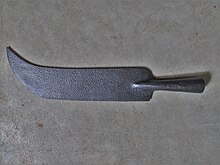
A polearm or pole weapon is a close combat weapon in which the main fighting part of the weapon is fitted to the end of a long shaft, typically of wood, extending the user's effective range and striking power. Polearms are predominantly melee weapons, with a subclass of spear-like designs fit for thrusting and/or throwing. Because many polearms were adapted from agricultural implements or other fairly abundant tools, and contained relatively little metal, they were cheap to make and readily available. When belligerents in warfare had a poorer class who could not pay for dedicated military weapons, they would often appropriate tools as cheap weapons. The cost of training was comparatively low, since these conscripted farmers had spent most of their lives using these "weapons" in the fields. This made polearms the favoured weapon of peasant levies and peasant rebellions the world over.
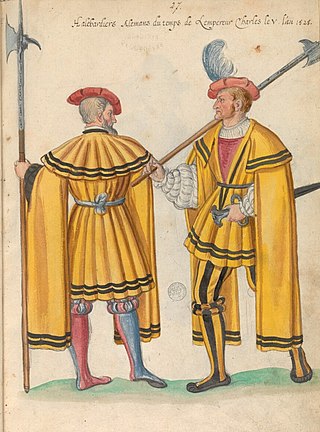
A halberd is a two-handed polearm that came to prominent use from the 13th to 16th centuries. The halberd consists of an axe blade topped with a spike mounted on a long shaft. It can have a hook or thorn on the back side of the axe blade for grappling mounted combatants. The halberd was usually 1.5 to 1.8 metres long.
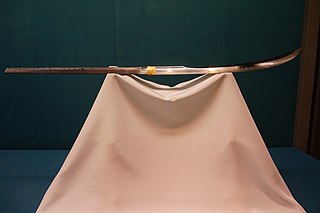
The naginata is a polearm and one of several varieties of traditionally made Japanese blades (nihontō). Naginata were originally used by the samurai class of feudal Japan, as well as by ashigaru and sōhei. The naginata is the iconic weapon of the onna-musha, a type of female warrior belonging to the Japanese nobility. A common misconception is that the Naginata is a type of sword, rather than a polearm.
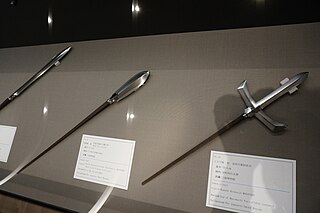
Yari (槍) is the term for a traditionally-made Japanese blade in the form of a spear, or more specifically, the straight-headed spear. The martial art of wielding the yari is called sōjutsu.

A scythe is an agricultural hand tool for mowing grass or harvesting crops. It is historically used to cut down or reap edible grains, before the process of threshing. The scythe has been largely replaced by horse-drawn and then tractor machinery, but is still used in some areas of Europe and Asia. Reapers are bladed machines that automate the cutting of the scythe, and sometimes subsequent steps in preparing the grain or the straw or hay.

A bill is a class of agricultural implement used for trimming tree limbs, which was often repurposed for use as an infantry polearm. In English, the term 'Italian bill' is applied to the similar roncone or roncola, but the Italian version tended to have a long thrusting spike in addition to the cutting blade.

A sickle, bagging hook, reaping-hook or grasshook is a single-handed agricultural tool designed with variously curved blades and typically used for harvesting or reaping grain crops, or cutting succulent forage chiefly for feeding livestock. Falx was a synonym but was later used to mean any of a number of tools that had a curved blade that was sharp on the inside edge such as a scythe.

A glaive, sometimes spelled as glave, is a type of pole weapon with historical origins in Europe, known for its distinctive design and versatile combat applications. It is similar to other polearms such as the war scythe, the Japanese naginata, the Chinese guandao, the Korean woldo, and the Russian sovnya.
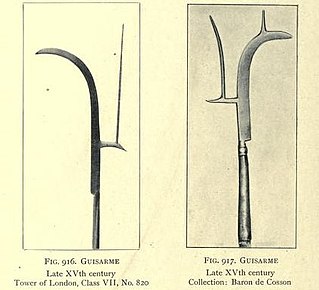
A guisarme is a polearm used in Europe primarily between 1000 and 1400. Its origin is likely Germanic, from the Old High German getīsarn, literally "weeding iron". Like many medieval polearms, the exact early form of the weapon is hard to define from literary references, and the identification of surviving weapons can be speculative.

A bardiche, berdiche, bardische, bardeche, or berdish is a type of polearm used from the 14th to 17th centuries in Europe. Ultimately a descendant of the medieval sparth axe or Dane axe, the bardiche proper appears around 1400, but there are numerous medieval manuscripts that depict very similar weapons beginning c. 1250. The bardiche differs from the halberd in having neither a hook at the back nor a spear point at the top. The use of bardiches started in early 14th-century Austria.

A guandao is a type of Chinese polearm that is used in some forms of Chinese martial arts. In Chinese, it is properly called a yanyuedao, the name under which it always appears in texts from the Song to Qing dynasties such as the Wujing Zongyao and Huangchao Liqi Tushi. It is comparable to the Japanese naginata and the European fauchard or glaive and consists of a heavy blade with a spike at the back and sometimes also a notch at the spike's upper base that can catch an opponent's weapon. In addition, there are often irregular serrations that lead the back edge of the blade to the spike. The blade is mounted atop a 1.5 to 1.8 m long wooden or metal pole and a pointed metal counterweight used to balance the heavy blade and for striking on the opposite end.
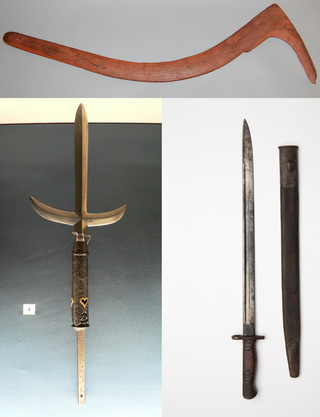
A melee weapon, hand weapon, close combat weapon or fist-load weapon is any handheld weapon used in hand-to-hand combat, i.e. for use within the direct physical reach of the weapon itself, essentially functioning as an additional extension of the user's limbs. By contrast, a ranged weapon is any other weapon capable of engaging targets at a distance beyond immediate physical contact.

The falx was a weapon with a curved blade that was sharp on the inside edge used by the Thracians and Dacians. The name was later applied to a siege hook used by the Romans.

A billhook or bill hook, also called a pruning knife or spar hook, is a versatile cutting tool used widely in agriculture and forestry for cutting woody material such as shrubs, small trees and branches. It is distinct from the sickle. It was commonly used in Europe with an important variety of traditional local patterns. Elsewhere, it was also developed locally such as in the Indian subcontinent, or introduced regionally as in the Americas, South Africa, and Oceania by European settlers.

A war scythe or military scythe is a form of pole weapon with a curving single-edged blade with the cutting edge on the concave side of the blade. Its blade bears a superficial resemblance to that of an agricultural scythe from which it is likely to have evolved, but the war scythe is otherwise unrelated to agricultural tools and is a purpose-built infantry melee weapon. The blade of a war scythe has regularly proportioned flats, a thickness comparable to that of a spear or sword blade, and slightly curves along its edge as it tapers to its point. This is different from farming scythes, which have very thin and irregularly curved blades, specialised for mowing grass and wheat only, unsuitable as blades for improvised spears or polearms.
A sovnya is a traditional polearm used in Russia. Similar to the glaive, the sovnya had a curved, single-edged blade mounted on the end of a long pole. This was a weapon used by late-medieval Muscovite cavalry and it retained use until the mid-17th century.

The scythe sword (Sensenschwert) was a type of single-edged sword of the German Renaissance, related to the Dussack. It consisted of the blade of a scythe to which a sword hilt was attached. Like the falx or falcata of antiquity, it was thus a curved sword with the cutting edge on the inside.

Many of the polearms used in Scotland up to the beginning of the 16th century were similar to those used in other parts of the world; however, a number of distinct forms did evolve. The nomenclature of Scottish axes, in particular, is confusing, and the text below follows the classification scheme proposed by David H. Caldwell in his 1980 paper "Some Notes on Scottish Axes and Long Shafted Weapons".

Niabor is a curved sword from Borneo, a characteristic weapon of the Sea-Dayaks.

